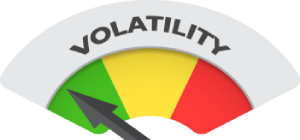Understanding Baccarat Volatility and Its Practical Usages
In regards to gambling, volatility refers to the ups and downs of winning and losing over time. Put simply, volatility relates to whether a game provides the occasional very big payout with not many winning rounds in between, which is a high-volatility game, or if it supplies regular small wins and very rare big wins, which is a low-volatility game.
Players from United States accepted
*T&Cs apply.
Baccarat has one of the lowest volatilities of all casino games. There are just three bets, Banker, Player and Tie, and the Banker hand has a 50.68% chance of winning in each round (without ties). It is the only fixed-odd casino bet where there is a greater than 50% chance of winning. This means that by using proper strategy, over time, it is possible to reduce the risk significantly when playing baccarat.
The Two Sides of Volatility

There are actually two aspects that can have an effect on a game’s volatility, and this is sometimes referred to as ‘The Two Sides of Volatility’. The first side is one that players control, the size of the bet placed. This is usually called bankroll management. The second side is the natural way that results change over time. This is, of course, the more important part of the equation as it is what decides whether the player wins or loses.
Understanding Volatility in Casino Games
An easy example to understand a low-volatility game is a coin flip that pays even money. There are just two possible results, so there is a 50/50 chance of winning each time. The wins won’t be big, but nor will the losses. Conversely, a high-volatility game would be a single number bet on roulette. It offers far higher returns of 35:1, but the chances of winning are far smaller, and therefore the losses will be greater.
It is common to see slots classified as being either low-, medium-, or high-volatility. Slots’ volatility is measured using their volatility index. Explained simply, if the percentage of money won from one slot machine is greater than from another, then the first slot has a higher volatility index.
Game Confidence Levels Explained
When a developer produces a casino game, three important statistics come into play. The best known of these is the Return to Player percentage (RTP). This is the theoretical percentage of what players should keep. The second is the hold percentage; this is the theoretical percentage of what the casino should retain. The third is known as the Confidence Level. This is the probability that the RTP and hold percentages will fall within the parameters set by the developer; usually, it is a 90% confidence level.
Volatility in Baccarat
As discussed, baccarat is one of the casino games with the lowest volatility. However, as it is a game that attracts high rollers who bet enormous amounts per hand, it can become extremely volatile for the casinos, which of course, benefits the players.

In baccarat, there is a 95% chance that a player will finish within two standard deviations of the expected result, which is between 75 units behind and 51 units ahead (where a unit is the amount bet). There is a 99.7% chance that a player will finish within three standard deviations of the expected result, which is between 107 units behind and 83 units ahead.
This means that it is very rare for a player to finish outside of these ranges. However, if a player is betting $150,000 (a unit), then the casino could lose a fortune. If the player finishes ahead at the two standard deviations level (which has a 95% confidence level), then the player would win 51 units. In other words, the casino would be paying out $7.65 million.
The problem is made worse for casinos as high stakes baccarat players tend to play a very limited number of hands. The more rounds played, the better things will be for the casino; however, a baccarat shoe (which contains around 70 hands) can take a high roller as long as three hours to play. The combination of a slow pace of play with very high stakes makes the game extremely volatile for casinos.
With the standard 1.2% house edge, a table with a maximum bet of $250,000 where 1,000 hands are played will have an expected win of $3 million. However, sticking to the two standard deviations, there will be anything between a $12.5 million loss for the casino and an $18.5 million win for the casino on 95% of occasions.
| Expected Value and Standard Deviation – $1 Banker Bet in Baccarat | ||||||
|---|---|---|---|---|---|---|
| X | P(X) | X*P(X) | X–EV | (X–EV)2 | (X–EV)2*P(X) | |
| +1 | 0.4462466 | +0.4462466 | 0.989421 | 0.978954 | 0.436855 | |
| -0.95 | 0.4585974 | -0.4356675 | -0.960579 | 0.922712 | 0.423153 | |
| 0 | 0.0951560 | 0 | -0.010579 | 0.000112 | 0.000011 | |
| EV = +0.0105791 | VAR = 0.860019 | |||||
| SD = 0.927372 | ||||||
What Influences Baccarat Volatility
There are two main things that influence baccarat volatility, the number of hands played and the size of the payout. As touched upon above, the number of bets (or rounds played) has a direct impact on the win percentage and the win amount. The more rounds played, the closer the amounts will come to the expected values in percentage terms. In other words, reality comes closer to matching the predicted values, the more rounds that are played. Furthermore, as explained above, bets that have a larger payout have a larger standard deviation. That is why high stakes play carries far greater risk for the casinos.
| Effect of Payout on Volatility | |||||
|---|---|---|---|---|---|
| 95% Margin of Error | |||||
| Payout | Prob | Expected Win % | 10,000 Bets | 100,000 Bets | |
| ROULETTE | |||||
| Even Money | 1 | .4737 | 5.26% | +/-2.00% | +/-0.63% |
| Column/Dozens | 2 | .3158 | 5.26% | +/-2.79% | +/-0.88% |
| Double Street | 5 | .1579 | 5.26 | +/-4.38% | +/-1.38% |
| 5-Number Bet | 6 | .1316 | 7.89% | +/-4.73% | +/-1.50% |
| Corner Bet | 8 | .1053 | 5.26% | +/-5.52% | +/-1.75% |
| Street | 11 | .0789 | 5.256% | +/-6.47% | +/-2.05% |
| Split | 17 | .0526 | 5.26% | +/-8.04% | +/-2.54% |
| Straight-up | 35 | .0263 | 5.26% | +/-11.53% | +/-3.64% |
| BACCARAT | |||||
| Banker | 0.95 | .4586 | 1.06% | +/-1.85% | +/-0.59% |
| Player | 1 | .4462 | 1.24% | +/-1.90% | +/-0.60% |
| Tie | 8 | .0952 | 14.36% | +/-2.64% | +/-0.84% |
Volatility in Other Casino Table Games
These principles of volatility can, of course, be applied to all casino table games, not just baccarat. Therefore, if you enjoy spending a bit of time away from the baccarat tables, whether at the roulette wheel or any other game, then it is worth considering volatility in those games as well.
One game where the above-discussed principles are highly relevant is roulette. When playing American Roulette, the RTP is always 94.75%, which means that statistically, you are always losing money. However, the bets have varying volatility. A straight-up bet is the most volatility (paying 35:1), while a low-volatility bet is an even-money bet, such as reds.
If you stick to low-volatility bets, then the RTP ensures that over time you will be losing money. However, if you place a high-volatility bet, you have a better chance of deviating from the negative expected results and winning money.
| Casino Win after 1,000 Bets on Red in Double-Zero Roulette (in units) | |
|---|---|
| Range | Probability |
| Less than -20 | 1.07% |
| -20 to 0 | 3.71% |
| 0 to 20 | 10.29% |
| 20 to 40 | 19.39% |
| 40 to 60 | 24.77% |
| 60 to 80 | 21.47% |
| 80 to 100 | 12.63% |
| 100 to 120 | 5.04% |
| 120 to 140 | 1.36% |
| More than 140 | 0.28% |
Many people are surprised to learn that blackjack is a volatile game. It is well-known that blackjack has a house edge of just 0.5% when it is played with perfect strategy. However, it is important to remember that a low house edge does not equal low volatility.
When people play without a perfect strategy, the dealer has a 5% edge in terms of frequency of wins. This edge can be reduced by following basic strategy, doubling down, and splitting at the correct moments. Furthermore, many tables offer an enhanced payout for natural blackjack, and this also reduces the edge.
However, in order to reduce the edge, it requires greater risk from the players. Players need to bet more through doubling down and splitting and need to play for longer to benefit from more enhanced payouts for natural blackjack. Expressed differently, players are waiting for bigger wins to cancel out their smaller losses, which is exactly what volatility is about.
Caribbean Stud Poker is another very popular and very volatile card game. Some hands will award payouts of five times the bet, and many games also offer a $1 side bet for the chance to win a progressive jackpot, which gives the impression that the game is risky for the casino. However, upon looking closer at the paytable, it becomes clear that this is not the case. The bottom of the paytable increases the house edge, and the game itself is designed to award occasional big payouts with the majority of hands losing. People often have the false impression that it is a low-volatility game as the regular losses are made up for with big wins, but it is, in fact, a high-volatility game.
Baccarat as a Low- and High-Volatility Game
There is no getting away from the fact that baccarat is a low-volatility game. However, by looking at the expected deviation from the win and the theoretical win, it becomes apparent there it can behave like a high-volatility game and provide the occasional big win. There is a high confidence level that players will finish ahead at the two standard deviations level. Of course, ultimately, it is gambling, and you could finish behind, but the mathematics of the volatility shows that it truly is possible to win significant amounts of money when playing baccarat.
| 22bet Casino | Live Side Bets | $1,500 | Read Review | |
| Betwinner Casino | Live Side Bets | $1,500 | Read Review | |
| Melbet Casino | Live Side Bets | $1,500 | Read Review |
*T&Cs apply